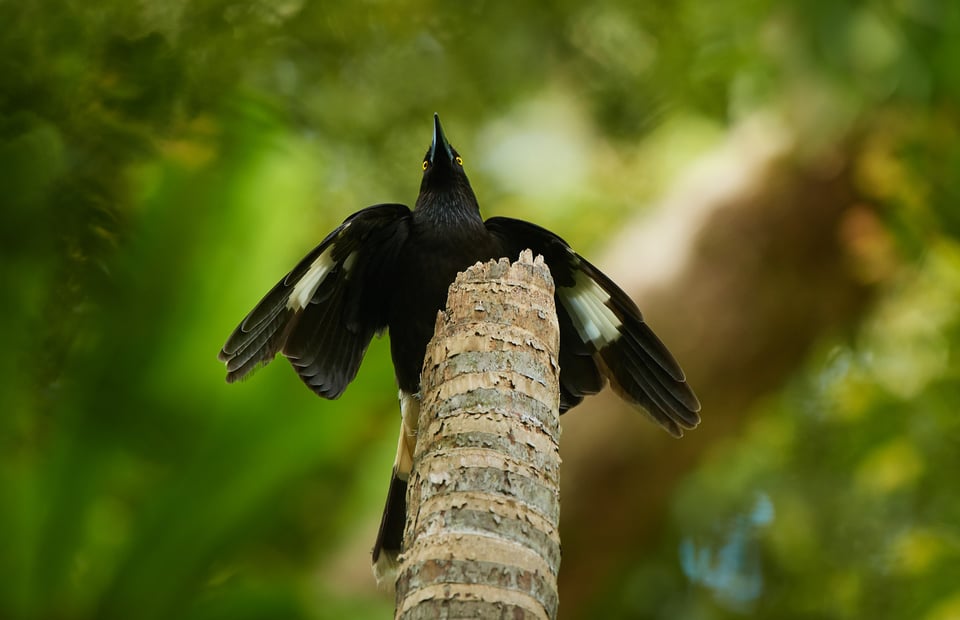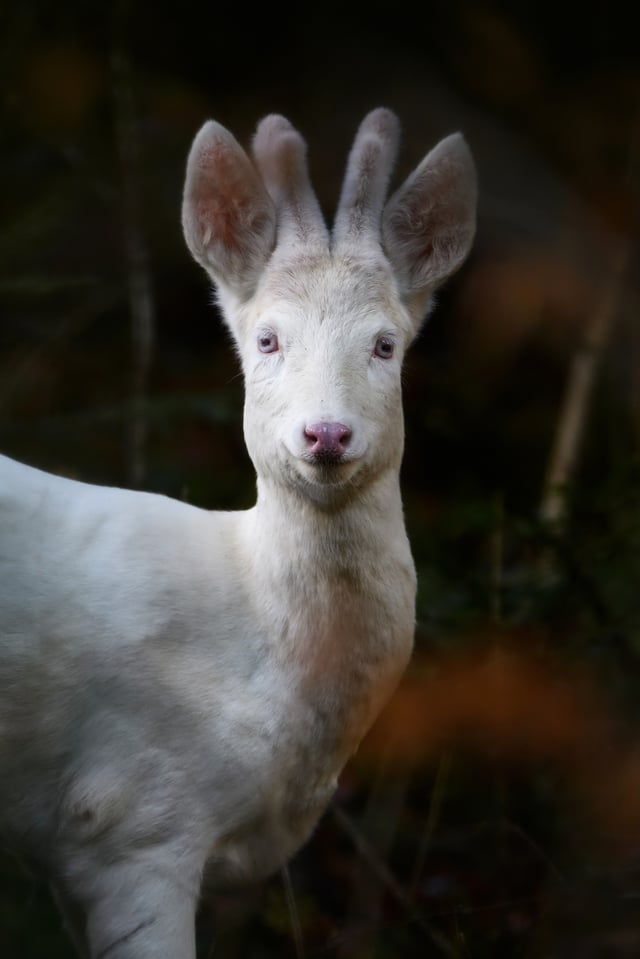Grab a bird field guide and flip through its pages quickly – so fast that you can feel a breeze against your face. As the pages flicker before your eyes like a cartoon, the flashes of colors will tell stories of evolution. These usually have two basic storylines. The color of a bird’s feathers either tells us something about the nature of the bird’s environment or about the sexual preferences of picky females. Occasionally, however, there are individuals whose coloration does not fit into either of these schemes, and those are the ones I’d like to talk about today.

Several mechanisms contribute to an animal’s coloration, the most common of which involve pigments. Mammals, with their relatively dull tones, rely on melanins and melanin derivatives in their skin. Birds, known for their dazzling colors, add carotenoids, lipochromes, and porphyrins to the mix. In addition, structural colors often interact with pigments, further expanding their visual palette.
Melanin, however, remains the basic pigment for both mammals and birds. It has two forms, pheomelanin (red-yellow tones) and eumelanin (brown-black tones), produced by specialized cells called melanocytes. But, genetic mutations can result in the complete or partial absence of this pigment in the skin (and, more rarely, in the retina), which is called albinism or leucism respectively.

Albino birds are completely white, and because they lack melanin in the retina as well, their eyes typically appear pink. Less commonly, some birds have a strikingly pale or patchy appearance, with eye color remaining normal, slightly lighter, or even blue, and this is called leucistic coloration.
You may have noticed strangely-colored birds in your area, which at first glance looked like the ones you see every day. It is in cities that leucistic birds can be seen more often than in the wild. There may be several reasons for this.

Leucism is often caused by recessive alleles of genes. For the trait to manifest, two such alleles must meet in the same body. It’s like rolling two dice and waiting for two sixes to come up. In small urban populations where there is no shortage of inbreeding, these rarer alleles are more likely to meet and cause a color change in the carrier.
Another reason that leucistic birds are more common in cities is the lower predation pressure, particularly from avian predators like hawks. Urban areas can serve as relatively safe havens for birds whose conspicuous plumage would otherwise make them easy targets in the wild.

Unusual plumage coloration can pose another major problem for an individual. Although it may not always affect their survival chances, it can have a dramatic impact on their reproductive success. Females of many birds are notoriously picky and obsessive about plumage pattern and color. A leucistic male can be a bad joke to them. Fortunately, there are tolerant Samaritans who will give these weirdos a chance, as some studies have shown.
Melanin in feathers also serves purposes beyond mere aesthetics. It acts as a structural reinforcement within the keratin matrix of feathers. Notice how even otherwise pure white gulls have black wingtips? Without melanin, feathers wear more quickly, potentially compromising flight efficiency, increasing energy expenditure, and once again increasing the risk of predation.

Then there’s the phenomenon first noticed by German zoologist Constantin Wilhelm Lambert Gloger in 1833. He observed that mammals and birds living in humid regions tend to be more heavily pigmented than their counterparts in drier, cooler climates. In addition to melanin’s critical role in UV protection, it turns out that melanin-rich feathers and fur are more resistant to bacterial degradation – something particularly useful in equatorial regions where microbes thrive.
In a previous article, I discussed structural colors, one of the relatively common sources of bird vibrancy. This time I’ve focused on the opposite phenomenon: genetic mutations that result in a complete or partial loss of coloration. Both albinism and leucism are relatively rare in nature, making any sighting of such an animal a special event. If you have ever been lucky enough to capture a photograph of a wild leucistic or even albino bird, I would love for you to share it with me. I’d be happy to include your image in an update of this article.
Leucistic birds through our readers’ lenses
After publishing my article, I was pleasantly surprised by the response from our readers. I’m really happy to see that you are not only exploring nature with your eyes wide open, but also keeping your cameras ready to capture extraordinary encounters. Sighting a leucistic or albino animal in the wild is certainly one of those rare moments. What makes me even happier is that I received photos from five different photographers, all capturing this interesting phenomenon. With their kind permission, I’d love to share them with you.











And now for something completely different. Let’s leave aside both birds and leucism for now. As mentioned earlier, the underlying cause of albinism is a congenital disorder that affects the production or transfer of melanin. Individuals with this condition are typically completely white (unless other pigments contribute to their coloration). Unlike leucistic individuals, albinos also lack melanin in their eyes, often giving them a characteristic red or pink hue.
Unfortunately, the missing melanin also affects vision, which ultimately proved fatal for the Roe Deer (Capreolus capreolus) in the following photos, kindly provided by Pierre Watson from Switzerland. This strikingly colored male lost his life a few months after Pierre photographed him – hit by a car after being chased from his territory by a rival, normally pigmented male.




Very interesting article, as always! I photographed an albino roe deer some years ago and would be happy to share my photos.
Just one comment to address the common misconception that all albino animals have pink eyes. Albinism is caused by a disruption in the body’s ability to produce melanin. As the production of melanin is a complex pathway involving many different genes, depending on the form of albinism, albino animals can have anywhere from pink to blue to even brown eyes. However it is true that the eyes are usually affected to some extend, both in eye color and in visual acuity as melanin is critical to eye development. Leucism on the other hand is a genetic condition affecting the melanocytes, the cells that produce melanin. Since the melanocytes in the eyes originate differently than in the rest of the body, leucistic animals almost always have normal eyes, both in color and function.
So while the eyes of albino animals are usually different than in normal animals, the eye color doesn’t necessarily have to be pink.
Thank you Pierre for the addition. It’s as you write. The mechanism of albinism and leucism is indeed different. Moreover, leucism is a bit of a shielding term for multiple ways that can manifest a similar phenotype.
I’d be very grateful for the roe deer photo. Please send them and a comment (2048px/max 1.5MB) to my email: [email protected]. Thank you very much.
These birds are really quite rare, aren’t they? Do you know if the nearly white Rock Dove variant with dark-reddish eyes is also a leucistic variety?
You’re right, Jason, that leucism is quite rare. However, with rock pigeon, I would probably first consider whether it is some genetic mixture after mating with a domestic pigeon. Can you send me a photo, please?
We had a leucistic Scrub Jay (we named her Lucy) living, courting, mating, and raising her babies in our yard for 9 yrs!! We last saw her last June after nesting season. We miss her dearly…
The beautiful gift was to have a bird we could positively identify as the same bird for all that time. We saw Lucy and her mate, who hung out together pretty much all the time, almost every day.
During all those years she had only one leucistic offspring. I of course have dozens (hundreds?) of photos of Lucy and Mr Jay…
This is a great advantage for us who watch the birds. Leucistic individuals are easily identifiable, so we can observe them as individuals. I used to be able to identify a magpie that lived near my house. It was normally coloured, but it had a very specific call. Unfortunately, it too is probably in bird heaven now. I’d love to see a Leucistic Scrub Jay. Could you please send me a photo that you think is a good one to my email [email protected]? Ideally at a resolution of 2048px long side and up to 1.5MB in size. If you post a comment on it, that would be great. Thank you very much Philip.
Hi Libor! An interesting phenomenon indeed! I got a few pictures of leucistic Eurasian Blackbirds, Eurasian Coots and Gray Wagtail in acceptable to good quality. My personal highlight in this regard was a completely white European Shag, although the pictures of that one aren’t particularly good (that was back in the age of analog photography and I was an absolute beginner without ideal equipment).
I’d happily share these pictures with you if you’re interested – please let me know how.
By the way, if you ever go to Iceland, watch out for whitish Starlings – it’s a quite common phenomenon there. Unfortulately, I never got any reasonable pictures.
I remember the joy of being one of the first to see/photograph an almost completely white Senegalese Thick-knee in The Gambia, the first ever occurrence there apparently. At the time, everyone thought it was albino but it later turned out to be leucistic, no pink eye.
That’s interesting, Rob. Do you have a picture you could share? Normally cryptically colored Thick-knee must have looked very strange.
Wow, those are great observations, Nightjar! Eurasian Blackbirds are quite typical. Maybe it’s their sedentary lifestyle. The dispersal of their offspring is quite low. They often stay for generations in the same city park. I’d be very happy if you send me your photos to my e-mail: [email protected]. Please write for each photo information where you took them + your own comment. Ideal resolution is 2048px longer side up to 1,5MB. Thank you very much.